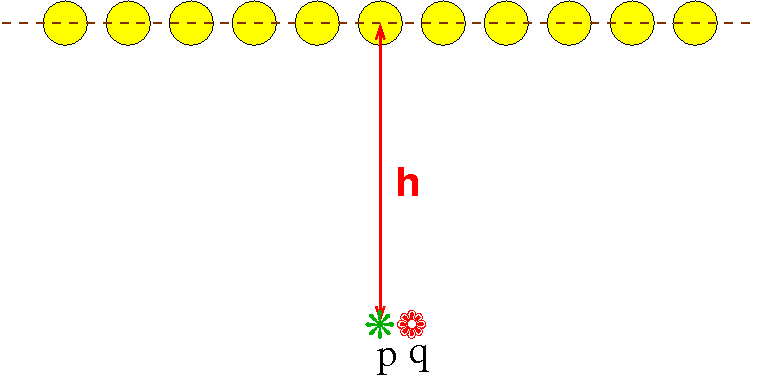CG ECSE-4750 Computer Graphics Final Exam, RPI, Mon 2019-12-16
Name, RCSID:
. .
Rules:
- You have 180 minutes.
- You may bring in two 2-sided 8.5"x11" papers with notes.
- You may not share material with each other during the exam.
- No collaboration or communication (except with the staff) is allowed.
- There are thirtytwo questions. Check that your copy of this test has all the pages.
- Each question is the same weight: five points.
Questions:
-
Name two major features that were present in the previous major version of OpenGL that were removed from the current version.
. .
-
What is the Mach band effect in the retina?
. .
-
What technical advance enabled frame buffers?
. .
-
Give an application of the vector triple product in computer graphics.
. .
-
What is the tristimulus model?
. .
-
In class we said that LCD displays combine pixels that emit three colors: red, green, and blue. However some experimental displays now have four colors; they also have yellow. Why do you think researchers are experimenting with these displays? I said that combining red and green gives yellow, and so having a yellow emitter shouldn't add any new capability?
. .
-
What does the javascript function window.alert do?
. .
-
What is the physical principle underlying LCD?
- Fire an energetic electron at a rare earth atom and a photon of light is emitted.
- Plowing your family farm as a kid can suggest an way to invent electronic television.
- A solution of corkscrew shaped molecules can rotate polarized light.
- Putting your finger close to a capacitor can change its capacitance.
- If two coils of wire are close, then an alternating current in one can induce a current in the other.
-
What is different about the wavelength of pure purple compared to pure red, green, or blue?
. .
-
Imagine that you're designing the specification of a picking routine. You're thinking about what to return when the user picks a particular pixel on the screen. Why is returning the line of code that colored that pixel insufficient?
. .
-
Double buffering solves which problem:
- producing stereo images
- low memory bandwidth
- remote debugging PCs
- displaying from a frame buffer while it's being updated
- optimizing scheduling two elevators as a group
-
Homogeneous coords have several advantages compared to cartesian coords. Give three.
. .
-
What is one disadvantage of homogeneous coords compared to cartesian? (This takes creative thinking since we didn't mention it in class).
. .
-
Generally in engineering, when several solutions to the same problem exist, each is sometimes the best. This question is about 3D rotation. (i) What is particularly good about the vector formula? (ii) What is particularly good about the matrix formula? (iii) What is particularly good about Euler angles?
. .
-
What type of vertex shader variable has the same value for each vertex?
- uniform variable
- varying variable
- constant variable
- variable constant
- lighting variable
-
Does the view normalization transformation preserve straight lines, angles, both, or neither?
. .
-
Quaternions: simplify (i+j)k.
. .
-
What is the purpose of v1 in this line of code?
var v2 = gl.getAttribLocation( program, "v1" );
. .
. .
-
If a 3x3 rotation matrix has eigenvalues \(1, -\frac{\sqrt{3}}{2}+\frac{1}{2}i, -\frac{\sqrt{3}}{2}-\frac{1}{2}i\), then what is the rotation angle (in degrees)?
. .
-
Give me a matrix M that has this property: for all vectors p, \(Mp = \begin{pmatrix}1 \\ 3 \\ 4\end{pmatrix} \times p\) .
. .
-
What is the normalized surface normal to the plane x+2y+3z+4=0?
. .
-
What is the difference between Gouraud shading and Phong shading?
. .
-
What is mipmapping? What problem does mipmapping solve?
. .
-
Beer companies sometimes hand out free cardboard glasses, which have a simple grey filter over one eye. When you watch a commercial with them, you see, sort of, a stereo effect. What property of your vision is this exploiting?
. .
-
What does it mean to separate the geometry from the topology?
. .
-
Name the best visibility algorithm when frame buffers are too expensive or too slow.
. .
-
What type of hardware was the Bresenham algorithm designed to be efficient on?
. .
-
Why do you need at least cubic degree for splines, i.e., why is quadratic too low?
. .
-
What does local control mean when designing with splines?
. .
-
Name one thing that is omitted from WebGL but that is in full OpenGL.
. .
-
When designing a spline curve, how do you deliberately reduce the degree of continuity at a joint?
. .
-
Why is there now a movement in CAD away from NURBS and back to using just lots of little flat triangles?
. .

